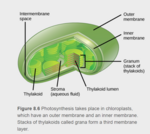
35 Results


BCC Bioscience Image Library is a media file repository of images and video clips made available to educators and students in the biological sciences. The resources are created by faculty, staff and students of Berkshire Community College and are licensed under Creative Commons 0. This means all content is free, with no restrictions on how the material may be used, reused, adapted or modified for any purposes, without restriction under copyright or database law.
This project was partially funded by a $20,000,000 grant awarded by the U.S. Department of Labor’s Employment and Training Administration, Grant # TC-26450-14-60-A-25. The product was created by the grantee and does not necessarily reflect the official position of the U.S. Department of Labor. The U.S. Department of Labor makes no guarantees, warranties, or assurances of any kind, express or implied, with respect to such information, including any information on linked sites and including, but not limited to, accuracy of the information or its completeness, timeliness, usefulness, adequacy, continued availability, or ownership.
If you have any questions contact professor Faye Reynolds at: freynold@berkshirecc.edu
- Subject:
- Biology
- Botany
- Life Science
- Material Type:
- Diagram/Illustration
- Author:
- Fayette A. Reynolds M.S.
- Date Added:
- 02/16/2022

The purpose of this resource is to measure and classify the plant life at a Land Cover Site to help determine the MUC classification.
- Subject:
- Applied Science
- Ecology
- Environmental Science
- Life Science
- Material Type:
- Activity/Lab
- Homework/Assignment
- Lesson Plan
- Teaching/Learning Strategy
- Provider:
- The GLOBE Program
- Provider Set:
- GLOBE Teacher's Guide NGSS Aligned Records
- Date Added:
- 01/09/2007
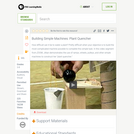
In this video segment from ZOOM, Jillian explains how her simple machine uses marbles, levers, flowing sand, and a spinning wheel to water a plant.
- Subject:
- Applied Science
- Chemistry
- Engineering
- Physical Science
- Physics
- Material Type:
- Activity/Lab
- Provider:
- PBS LearningMedia
- Provider Set:
- PBS Learning Media: Multimedia Resources for the Classroom and Professional Development
- Author:
- National Science Foundation
- WGBH Educational Foundation
- Date Added:
- 02/20/2004
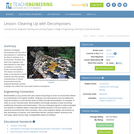
Students investigate decomposers and the role of decomposers in maintaining the flow of nutrients in an environment. Students also learn how engineers use decomposers to help clean up wastes in a process known as bioremediation. This lesson concludes a series of six lessons in which students use their growing understanding of various environments and the engineering design process, to design and create their own model biodome ecosystems.
- Subject:
- Applied Science
- Ecology
- Engineering
- Life Science
- Material Type:
- Activity/Lab
- Lesson Plan
- Provider:
- TeachEngineering
- Provider Set:
- TeachEngineering
- Author:
- Denise W. Carlson
- Katherine Beggs
- Malinda Schaefer Zarske
- Date Added:
- 09/18/2014
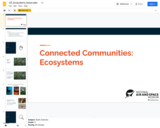
This lesson explores ecosystems and how living things are interconnected.
- Subject:
- Life Science
- Material Type:
- Lesson Plan
- Provider:
- National Air and Space Museum
- Author:
- National Air and Space Museum
- Date Added:
- 09/06/2022

This resource is a video abstract of a research paper created by Research Square on behalf of its authors. It provides a synopsis that's easy to understand, and can be used to introduce the topics it covers to students, researchers, and the general public. The video's transcript is also provided in full, with a portion provided below for preview:
"Microbes play essential roles in plant health for sustainable agriculture. A better understanding of plant microbiota could lead to strategies for regulating plant growth, enhancing stress tolerance, and reducing pathogenesis. High-throughput 16S rRNA gene sequencing is a useful method for studying bacterial community structures. Unfortunately, in plants, contamination of the 16S rRNA genes from the mitochondrion and plastid hinders sensitivity. Now, new research presents a novel method of reducing host contamination for plant microbiota profiling. The technique uses Cas9 and specific guide RNA to cut 16S rRNA targets, removing host contamination for 16S sequencing. In a feasibility test, Cas-16S-seq reduced the fraction of rice 16S rRNA gene sequences from 63.2% to 2.9% in roots and from 99.4% to 11.6% in leaf samples..."
The rest of the transcript, along with a link to the research itself, is available on the resource itself.
- Subject:
- Biology
- Life Science
- Material Type:
- Diagram/Illustration
- Reading
- Provider:
- Research Square
- Provider Set:
- Video Bytes
- Date Added:
- 10/30/2020

This resource is a video abstract of a research paper created by Research Square on behalf of its authors. It provides a synopsis that's easy to understand, and can be used to introduce the topics it covers to students, researchers, and the general public. The video's transcript is also provided in full, with a portion provided below for preview:
"Plants are shaped by the many microbes they host. But scientists are only beginning to understand how, especially in underexplored plant structures like aerial roots. A new study shows that the mucilage secreted by these roots can create a microbiome unlike that found in underground roots and nurture an environment that caters to beneficial, nitrogen-fixing bacteria. Researchers made these discoveries by examining the aerial roots of pink lady shrubs—a fast-growing invasive plant. Metabolite profiling of aerial root mucilage revealed a rich cocktail of nutrients that would be expected to support an equally rich variety of microbes. But genomic analyses suggested a mucilage community dominated by nitrogen-fixing diazotrophs. This homogeneous community structure was linked to the presence of the fungus C. raphigera. The antibacterial activity of this fungus was such that only diazotrophs were allowed to thrive, to the benefit of the pink lady shrubs..."
The rest of the transcript, along with a link to the research itself, is available on the resource itself.
- Subject:
- Biology
- Life Science
- Material Type:
- Diagram/Illustration
- Reading
- Provider:
- Research Square
- Provider Set:
- Video Bytes
- Date Added:
- 05/01/2023
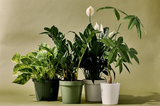
There are many uses of plants in our day to day life. But we don't know what are the different types of plants based on the characteristics.
- Subject:
- Applied Science
- Material Type:
- Module
- Author:
- Pushti Parmar
- Date Added:
- 08/28/2019
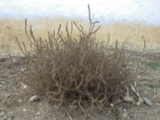
Elementary Science and Integrated Subjects is a statewide Clime Time collaboration among ESD 123, ESD 105, and the Office of Superintendent of Public Instruction. Development of the resources is in response to a need for research- based science lessons for elementary teachers that are integrated with English language arts, mathematics and other subjects such as social studies. The template for Elementary integration can serve as an organized, coherent and research-based roadmap for teachers in the development of their own NGSS aligned science lessons. Lessons can also be useful for classrooms that have no adopted curriculum as well as to serve as enhancements for current science curriculum. The EFSIS project brings together grade level teams of teachers to develop lessons or suites of lessons that are 1) focused on grade level Performance Expectations, and 2) leverage ELA and Mathematics Washington State Learning Standards.
- Subject:
- Education
- Elementary Education
- Environmental Science
- Life Science
- Material Type:
- Activity/Lab
- Reading
- Author:
- Georgia Boatman
- Barbara Soots
- Ellen Ebert
- Kimberley Astle
- Washington OSPI OER Project
- Date Added:
- 06/22/2020

Elementary Science and Integrated Subjects is a statewide Clime Time collaboration among ESD 123, ESD 105, and the Office of Superintendent of Public Instruction. Development of the resources is in response to a need for research- based science lessons for elementary teachers that are integrated with English language arts, mathematics and other subjects such as social studies. The template for Elementary integration can serve as an organized, coherent and research-based roadmap for teachers in the development of their own NGSS aligned science lessons. Lessons can also be useful for classrooms that have no adopted curriculum as well as to serve as enhancements for current science curriculum. The EFSIS project brings together grade level teams of teachers to develop lessons or suites of lessons that are 1) focused on grade level Performance Expectations, and 2) leverage ELA and Mathematics Washington State Learning Standards.
- Subject:
- Education
- Elementary Education
- English Language Arts
- Life Science
- Measurement and Data
- Reading Informational Text
- Material Type:
- Activity/Lab
- Reading
- Unit of Study
- Author:
- Georgia Boatman
- Barbara Soots
- Ellen Ebert
- Kimberley Astle
- Washington OSPI OER Project
- Date Added:
- 06/09/2020

The purpose of this resource is to observe plant green-down and report greendown data to help validate estimates of the end of the plant growing season. Students monitor the change in color of selected leaves of trees, shrubs or grasses.
- Subject:
- Applied Science
- Ecology
- Environmental Science
- Life Science
- Material Type:
- Activity/Lab
- Homework/Assignment
- Interactive
- Lesson Plan
- Teaching/Learning Strategy
- Provider:
- UCAR Staff
- Provider Set:
- GLOBE Teacher's Guide NGSS Aligned Records
- Author:
- The GLOBE Program, University Corporation for Atmospheric Research (UCAR)
- Date Added:
- 01/09/2007

The purpose of this resource is to observe plant green-up and report data that will be used by scientists to validate satellite estimates of the beginning of the plant growing season. Students monitor budburst and growth of leaves of selected trees, shrubs, or grasses. Species chosen should be native, deciduous, and dominant in your area.
- Subject:
- Applied Science
- Ecology
- Environmental Science
- Life Science
- Material Type:
- Activity/Lab
- Homework/Assignment
- Interactive
- Lesson Plan
- Teaching/Learning Strategy
- Provider:
- UCAR Staff
- Provider Set:
- GLOBE Teacher's Guide NGSS Aligned Records
- Author:
- The GLOBE Program, University Corporation for Atmospheric Research (UCAR)
- Date Added:
- 01/09/2007
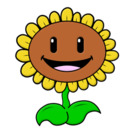
This Lesson Plan is an inquiry based lesson plan that is geared towards third graders. It teaches them about all the different parts of a plant and what makes a plant grow and how they grow. I created this lesson plan with two other classmates. Through this lesson plan the students will be split into groups. Each group will be assigned a flower. They will research their flower and figure out what they need in order to grow (amount of water, amount of sunlight, etc.). They will grow their flowers in class and watch as they change over time!
- Subject:
- Environmental Science
- Material Type:
- Lesson Plan
- Author:
- Lizzie Michael
- Date Added:
- 11/30/2017
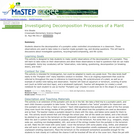
Students observe the decomposition of a pumpkin under controlled circumstances. These observations are used to take notes and develop questions.
- Subject:
- Biology
- Life Science
- Material Type:
- Activity/Lab
- Lesson Plan
- Provider:
- Science Education Resource Center (SERC) at Carleton College
- Provider Set:
- Pedagogy in Action
- Date Added:
- 01/20/2012

Explains what a growing plant needs to stay healthy and what happens when a plant is lacking a necessary factor. Includes group activity, individual activity, and homework.
- Material Type:
- Activity/Lab
- Homework/Assignment
- Lesson Plan
- Date Added:
- 05/05/2015

This lesson plan explains how seeds can be dispersed, describes seed adaptations to ensure dispersal and explain the importance of this process.
- Material Type:
- Activity/Lab
- Homework/Assignment
- Lesson Plan
- Date Added:
- 05/05/2015

Creators: Diljot Kahlon, Flora Che
- Subject:
- Education
- Educational Technology
- Elementary Education
- Material Type:
- Game
- Lesson Plan
- Author:
- Diljot Kahlon
- Date Added:
- 04/01/2022

Explains what a growing plant needs to stay healthy and what happens when a plant is lacking a necessary factor. Includes group activity, individual activity, and homework.
- Material Type:
- Activity/Lab
- Homework/Assignment
- Lesson Plan
- Date Added:
- 01/28/2015

This resource is a video abstract of a research paper created by Research Square on behalf of its authors. It provides a synopsis that's easy to understand, and can be used to introduce the topics it covers to students, researchers, and the general public. The video's transcript is also provided in full, with a portion provided below for preview:
"Domesticated edible insects are a sustainable protein source that has been gaining global attention. P. brevitarsis is one such species, and their larvae can also eat decaying organic waste and turn it into a plant-growth promoting mixture. But organic matter like this is high in lignocellulose, which is difficult to digest. In fact, these larvae lack the enzymes needed to break lignocellulose down on their own. So, researchers checked their microbiome for microbial genes able to fill in the gaps. The researchers established a comprehensive reference catalog of gut microbial and host genes. Between the two sets of genes, lignocellulose-degrading enzymes were abundant and highly diversified. P. brevitarsis larvae also selectively enriched their microbiome for lignocellulose-degrading microbes and had physiological adaptations that assisted in lignocellulose degradation..."
The rest of the transcript, along with a link to the research itself, is available on the resource itself.
- Subject:
- Biology
- Life Science
- Material Type:
- Diagram/Illustration
- Reading
- Provider:
- Research Square
- Provider Set:
- Video Bytes
- Date Added:
- 04/14/2023